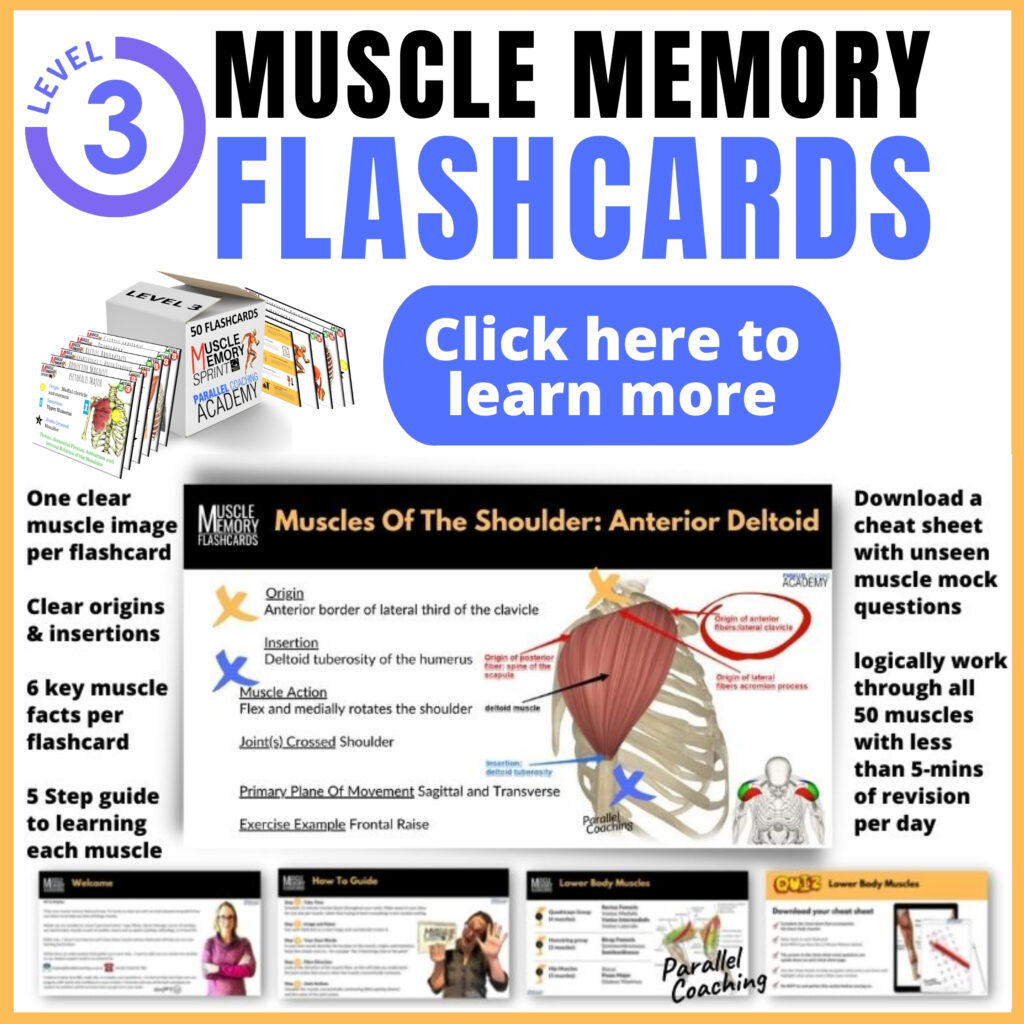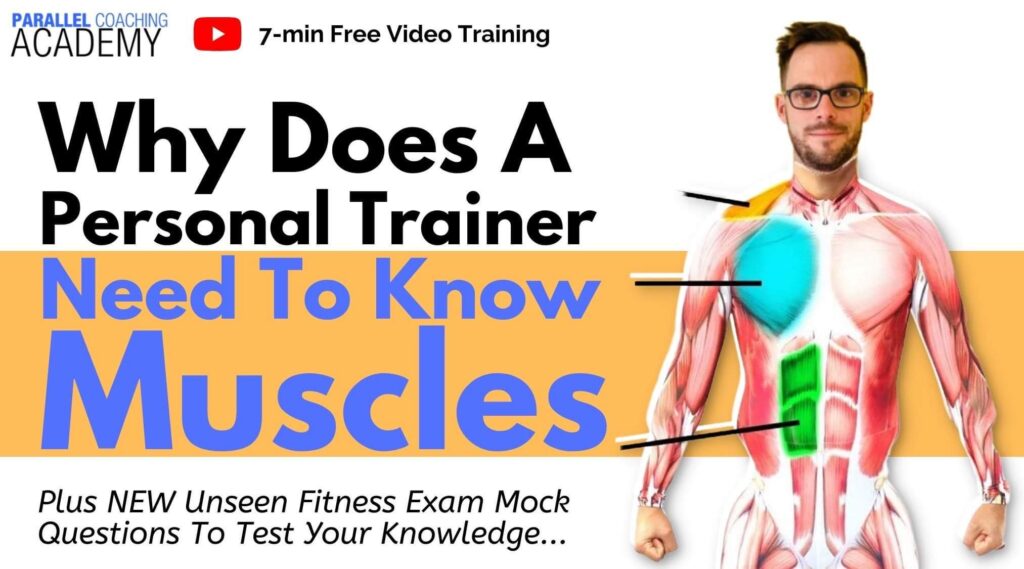In today’s video training, you’ll learn the reasons Why Does A Personal Trainer Need To Know Muscles.
If you’ve been trying to learn muscles and struggle to understand why learning the origin and insertion of muscles is important, then we’ve got you covered.
First of all, watch the 6-minute video tutorial and then test your knowledge using the three mock questions at the bottom of this blog.
Watch: Why Does A Personal Trainer Need To Know Muscles?
Learning muscles for your PT exam
Firstly, muscles have been a key part of the level 3 anatomy and physiology exam and have always been part of the level 3 Personal Trainer syllabus. This is not because the awarding bodies wanted to give you an exam, but because of its importance in understanding other concepts in the PT syllabus.
As part of your qualification to become a personal trainer you need to learn 35 muscles at level 2 Anatomy, and 50 muscles at Level 3 anatomy.
You need to know 5 different facts per muscle, which equates to 250 pieces of information. This can sound like a lot, so it is important you see the value in learning this, not just for your exam, but also as a personal trainer.
What you need to know about Muscles as a PT
For each of the muscles you are revising, you need to know these 5 pieces of information:
- Name
- Location
- Origin
- Insertion
- and Joint Action
if you are finding it hard to remember these 5 facts for every muscle, scroll down to find out how our Muscle Memory flashcards will help
Muscle knowledge and exercise prescription
Yes, you need to know about muscles for your PT exam, but you also need to know it so you can operate as an effective trainer and coach. If you don’t know which muscle does what joint action, it will make programming for your clients very difficult.
Every exercise you prescribe as a Personal Trainer is chosen for a reason, in order to target a specific muscle. Let’s just say you’re doing a whole-body approach programme for your client, and you need exercises for the legs, chest, back, lats, shoulders and core… how do you know which exercises to include, if you don’t understand about the muscles first?
Or maybe you notice your client has a kyphotic postural compensation, whereby the chest is tight and the mid-trapezius and rhomboids are lengthened/ weak. With knowledge of the muscles, you can include exercises that activate and strengthen the trapezius and rhomboids, and include stretches to lengthen the pectoralis major.
You may even be looking for new exercises or stretches that target a specific muscle. You can only work these out if you know where each muscle originates and inserts, and the joint actions created when they contract.
Correcting posture and technique
With every repetition of a resistance exercise or every step in their cardiovascular exercise, your client’s posture varies.
It is only when you fully understand the muscles of the body, that you can check your client is performing optimally.
Let’s just say your client is doing a sit-up but their spine is staying straight throughout and they are creating large amounts of flexion at the hips. Your knowledge of the muscles allows you to see what muscles are being targeted. Here the knowledgeable PT can see that the client is relying on the hip flexors to create flexion at the hip, and is not using his rectus abdominus (which creates spinal flexion, and doesn’t cross the hips).
This is why a Personal Trainer Need To Know Muscles. So they can observe and correct their clients, to improve performance and improve efficiency on the target muscle.
Test your knowledge with 3 Muscles Mock Questions
Look at the Muscle Anatomy and Physiology Mock questions below and jot down your answer on scrap paper or as a note in your phone.
Then scroll down to reveal the answers.
1) What action occurs when the muscle fibres of the Gastrocnemius concentrically contract?
A. Plantarflexion
B. Retraction
C. Dorsiflexion
D. Knee Extension
2) What is the insertion of the Pectoralis Major muscle?
A. Scapula
B. Femur
C. Humerus
D. Sternum
3) Which exercise does NOT work the Biceps Brachii muscle?
A. Lat Pull Down
B. Lateral Raise
C. Seated Row
D. Upright Row
Answers:
Q1: Answer = A
Q2: Answer = C
Q3: Answer = B
If you want more mock questions like this, then you can download more Free Mock Questions: DOWNLOAD NOW
How to learn origins and insertions?
Learn, Revise & Remember All 50 Muscles In The Level 3 Anatomy & Physiology Exam.
(and the BEST part…You can do all this in as little as 5-minutes a day)
Each flashcard gives you a clear image and six clear muscle facts:
- Name and Location
- Origin and Insertions
- Muscle Actions
- Joints Crossed
- Primary Planes Of Movement
- Exercise Examples

Dedicated to More
Hayley “Why Does A Personal Trainer Need To Know Muscles?” Bergman
Parallel Coaching
P.S. You can also find us on the following platforms:
Instagram: Follow Now
Facebook: Like Our Page
Twitter: Tweet Us
YouTube: Subscribe Here
More Muscle Revision Blogs: HERE

